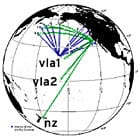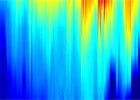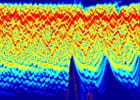Ocean Acoustics
Whether the objective is to map the ocean floor or determine the location of marine life, acoustics allows scientists to investigate large areas of the ocean or examine intricate water column properties.

Propagation and Scattering
Research focuses on the proliferation and scattering of sound in the ocean in small regions or over an entire ocean basin. The scattering of sound is affected by marine life, seafloor structure, and physical oceanographic processes like internal waves and turbulence. Acoustics can be used to detect biological and geological objects, and to probe oceanographic processes.
» Marine Animal Remote Sensing Laboratory
» Underwater Acoustic Projector

Inverse Problems and Tomography
Ocean acoustic tomography is a tool used to study average temperatures over large regions of the ocean. By measuring the time it takes sound to travel between known source and receiver locations, sound speed can be determined. Changes in sound speed are then related to changes in temperature.
» Acoustic Tomography & Global Ocean Monitoring
» Acoustic Communications Group

Acoustic Communication and Signal Processing
Acoustic signals provide a means to measure ocean properties and transmit information through the ocean. Research in the communications and adaptive signal processing areas focuses on understanding the impact of environmental processes on the propagation of acoustic signals in realistic ocean environments and on developing adaptive algorithms that exploit or compensate for characteristics of the ocean environment. Other research in this area seeks to improve or develop new acoustic instrumentation.
» Acoustic Communications Group
» Acoustical Beam Propagation
» Underwater Acoustic Projector
